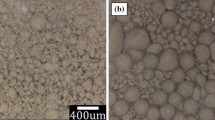Pre- and post-reactor studies of the properties of modified uranium dioxide fuel fabricated by a modernized water technology, including cooling of ammonium polyuranate with large and nanosize particles obtained simultaneously followed by calcination, reduction, pressing, and sintering of pellets, were performed. The properties of such fuel are compared with those of fuel obtained by the standard water technology. It is found that the heat capacity and thermal conductivity of such fuel are 1.8–2 times higher than the reference values and that the fuel possesses high microstructural stability and capacity for retaining gaseous fission products during irradiation. This is due to special properties: the presence of nanodispersity in grains and metal clusters in which the uranium ions form U–U chemical bonds with one another.
Similar content being viewed by others
References
I. C. Kurina, V. V. Popov, and V. V. Rumyantsev, “Investigation of the properties of modified uranium dioxide,” At. Énerg., 101, No. 5, 347–352 (2006).
I. C. Kurina, V. V. Popov, and V. V. Rumyantsev, Patent No. 2323912 RF, “Method of fabricating articles from oxide ceramic with high thermal conductivity,” Byull. Otkr. Polezn. Modeli, No. 13, Pt. IV, 917 (2008).
I. S. Kurina, “Improvement of the technologies for the fabrication of uranium dioxide fuel in order to improve performance characteristics,” Functional Nanomaterials for Power Generation: 1st All-Rus. School-Seminar of Students, Postgrad., and Young Sci., NIYaU MIFI, Moscow (2011), pp.117–146.
A. G. Biryukova, V. D. Vorontsova, B. A. Kuznetsov, et al., Patent No. 2296106 RF, “Method of obtaining pelleted fuel based on uranium dioxide powder,” Byull. Izobret. Polezn. Modeli, No. 9, Pt. II, 374–375 (2007).
A. A. Maiorov and I. B. Braverman, Technology of Obtaining Powders of Ceramic Uranium Dioxide, Energoatomizdat, Moscow (1985).
J. Woolfrey, “Surface area changes during the thermal decomposition of ammonium urinate,” J. Inorg. Nucl. Chem., 38, 347–348 (1976).
I. S. Kurina, O. V. Serebrennikova, S. S. Rogov, and A. Yu. Kazakova, “Investigation of the properties of precipitates of ammonium polyuranates and UO2 powders and pellets obtained by different technologies,” At. Énerg., 110, No. 3, 141–146 (2011).
C. Wagner, W. Riggs, L. Davis, et al., Handbook of x-Ray Photoelectron Spectroscopy, Perkin-Elmer Corp., Eden Prairie, USA (1978), pp. 166–167.
S. Senanayake et al., “Carbon monoxide reaction with UO2 (111) single crystal surfaces: a theoretical and experimental Study,” J. Vac. Sci. Technol. A, 23, No. 4, 1078–1084 (2005).
Shen Vun Chong, Interactions of Oxygenated Organic Molecules on the (111) Surfaces of a Uranium Dioxide Single Crystal: DPh Thesis (2001).
I. S. Kurina, V. V. Popov, V. N. Rumyantsev, and A. M. Dvoryashin, “Investigation of the properties of modified oxides with anomalously high thermal conductivity,” Persp. Mater., No. 3, 38–45 (2009).
Yu. I. Likhachev and V. Ya. Pupko, Strength of Fuel Elements of Nuclear Reactors, Atomizdat, Moscow (1975).
I. S. Kurina, V. V. Popov, and V. N. Rumyantsev, “Use of modifi ed UO2 with improved performance for fast reactors,” Heavy Liquid-Metal Coolants in Nuclear Technologies (TZhMT-2013), Obninsk (2013), Vol. 2, pp. 479–488.
J. Fink, “Thermophysical properties of uranium dioxide. Review,” J. Nucl. Mater., 279, No.1, 1–18 (2000).
R. B. Kotel’nikov, S. N. Bashlykov, A. K. Kashtanov, and T. S. Men’shikova, High-Temperature Nuclear Fuel, Atomizdat, Moscow (1978).
C. Amelinckx, “Physical Properties of UO2 Single Crystals,” Eurat. Quart. Rep., No. 2 (1962).
J. Bates, “Thermal conductivity of UO2 improves at high Temperatures,” Nucleonics, 19, No. 6, 83–87 (1961).
S. P. Gubin, Chemistry of Clusters, Nauka, Moscow (1987).
B. G. Livshits, V. S. Kraposhin, and Ya. L. Linetskii, Physical Properties of Metals and Alloys, Metallurgiya, Moscow (1980).
E. G. Shramkov (ed.), Electric Measurements, Vysshaya Shkola, Moscow (1972).
J. Bates, C. Hinman, and T. Kawada, Electrical Conductivity of UO 2 : Single Crystals, Pt. I, BNWL-296 (1966).
J. Bates, Electrical Conductivity of UO 2 , Pt. II, Final Rep. BNWL-296 (1967).
Yu. A. Brusentsov and A. M. Minaev, Principles of the Physics and Technology of Oxide Semiconductors, Izd. TGTU, Tambov (2002)
I. S. Kurina, V. V. Popov, and V. N. Rumyantsev, and A. M. Dvoryashin, “Development and research of the modified oxide fuel with improved performance,” Proc. Techn. Meeting on Design, Manufacturing and Irradiation Behaviour of Fast Reactors Fuels: IAEA-TECDOCCD-1689 (2013), pp. 103–115.
Author information
Authors and Affiliations
Additional information
Translated from Atomnaya Énergiya, Vol. 119, No. 3, pp. 155–164, September, 2015.
Rights and permissions
About this article
Cite this article
Kurina, I.S., Popov, V.V., Rumyantsev, V.N. et al. Investigation of Modified UO2 Fuel with Anomalously High Thermal Conductivity. At Energy 119, 190–199 (2016). https://doi.org/10.1007/s10512-015-0047-x
Received:
Published:
Issue Date:
DOI: https://doi.org/10.1007/s10512-015-0047-x



